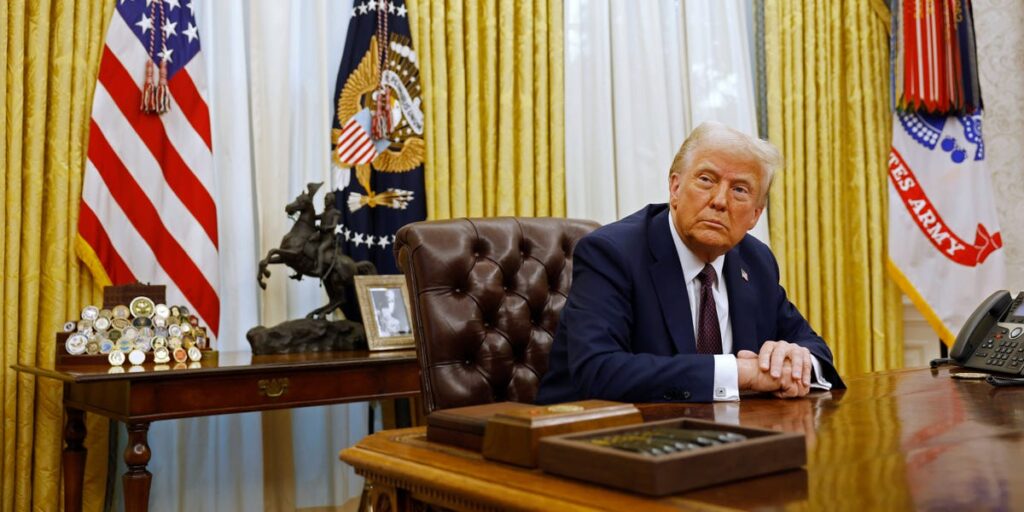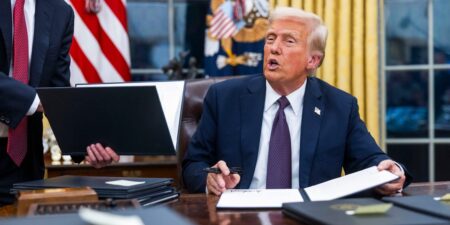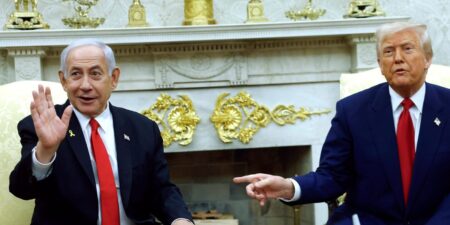subscribers. Become an Insider
and start reading now.
Have an account? .
- President Trump is steering the federal government in a distinctly conservative direction.
- Upon entering office for his second term, he signed a slew of executive orders to achieve this goal.
- There are many key dates to look out for as the administration continues to roll out its agenda.
Nearly three months into his second term, President Donald Trump’s sweeping agenda continues to take shape. The president has signed executive orders on everything from return-to-office mandates to strict immigration measures.
For weeks, the threat of tariffs loomed, with Trump early on reserving his focus on Canada, China, and Mexico.
Then, on April 2, which the president dubbed “Liberation Day,” he signed an executive order putting into place a 10% baseline tariff on imports from all countries. And some countries, including Cambodia and Lesotho, were slapped with some of the highest “reciprocal” tariff rates.
Here’s a look at some of the key dates for initiatives and plans put into place by the Trump administration:
February 1: Tariffs enacted for Canada, China, and Mexico
Shortly after the November general election, Trump vowed to impose 25% tariffs on imported goods from Canada and Mexico, two of the United States’ leading trading partners.
Trump said both countries have allowed drugs and migrants to pour into the US, which ties squarely into the president’s hard-line stance on immigration issues.
Trump also floated a 10% across-the-board tariff on Chinese goods.
On February 1, the president followed through on his pledge, enacting the tariffs for all three countries.
As part of his executive orders, Canadian energy products would have a 10% tariff rate.
February 3: Trump paused tariffs for Canada and Mexico
Trump, on February 3, agreed to a 30-day pause on his administration’s tariffs on Canadian and Mexican goods.
Then-Canadian Prime Minister Justin Trudeau and Mexican President Claudia Sheinbaum both said they’d enact security plans at their respective borders with the United States.
Sheinbaum said she’d send 10,000 of her country’s national guard troops to the border to stop the flow of fentanyl into the United States. Trudeau said that Canada would appoint a fentanyl czar and bolster intelligence-gathering efforts regarding the flow of illicit drugs, among other directives.
February 4: China responds with tariffs on select US imports
Beijing responded to Trump’s tariffs on China on February 4 by imposing a 10% tariff on crude oil, agricultural machinery, pickup trucks, and some large cars.
China is also targeting the United States by imposing an additional 15% tariff on coal and natural gas.
February 6: Deadline for federal workers to accept buyout
The Office of Personnel Management issued a letter on January 28 offering all federal employees payouts and giving them a February 6 deadline to accept the offer.
Federal employees who accepted the administration’s offer by the deadline “will retain all pay and benefits regardless of your daily workload and will be exempted from all applicable in-person work requirements until September 30 (or earlier if you choose to accelerate your resignation for any reason),” the letter on the OPM’s website read.
The buyout offer came as Trump has quickly sought to not only reduce the size of the federal workforce but also install loyalists in key positions within the government.
The Trump administration in February announced that roughly 77,000 federal workers accepted the offer.
On February 12, a federal judge in Massachusetts ruled that the administration could proceed with its buyout offer after three federal employee unions filed a lawsuit on behalf of their members to halt the buyout program.
The administration then promptly closed the window for any additional federal employees to accept the offer.
February 7: First jobs report under Trump
The first employment situation report for Trump’s second term was released on February 7. At the time, the Bureau of Labor Statistics reported that 143,000 jobs were created in January 2025.
In March 2025, the total nonfarm payroll employment for December 2024 was revised up, with the number of jobs created increasing from 307,000 to 323,000.
However, in April 2025, the number of jobs created in January 2025 was revised down to 111,000.
Trump’s second term began on January 20, so the report mostly featured employment data from former President Joe Biden’s last month in office.
February 7: Deadline for agencies to have plans for federal workers to return to the office
The Trump administration set February 7 as the date for federal agencies to develop plans for adhering to the president’s return-to-work order for employees.
The implementation plans are expected to be vetted and approved by the Office of Personnel Management and the Office of Management and Budget.
March 4: Tariffs announced for Canada, China, and Mexico
Trump placed 25% tariffs on imports from Canada and Mexico.
The president also bumped the tariff on Chinese goods to 20%.
March 6: Tariffs on most imports from Canada and Mexico are suspended
Trump temporarily suspended the 25% tariffs that he imposed on most goods from Canada and Mexico just days earlier.
March 7: Jobs report released for the first full month of Trump’s second term
The initial February 2025 jobs report, which included Trump’s first full month in office, showed that 151,000 jobs were created.
That month, the unemployment rate sat at 4.1%.
In April 2025, the February numbers were revised to reflect that 117,000 jobs were created that month.
During the 2024 presidential race, Trump ran on promises to reduce inflation and lower food costs, as well as to make the broader economy more prosperous for a wide swath of Americans.
Trump enjoyed a critical advantage on the economy during the campaign, but within weeks of taking office, he began to see some erosion on this issue. In a CNN/SSRS poll released in March, most US adults expressed disapproval of his handling of tariffs.
March 21: Deadline to eliminate most DEI offices and positions
On Inauguration Day, Trump signed an executive order to end “illegal and immoral discrimination” Biden-era programs implemented to promote diversity, equity, and inclusion.
Trump and many of his Republican allies have rallied against DEI initiatives. Their pressure campaign has begun to spill over into corporate America, with top companies like Target rolling back some diversity-focused efforts.
Some agencies have already put employees on paid leave. Officials are also submitting lists of names to the White House, Government Executive reported.
By late March, Trump’s executive order called for each agency head — to the maximum extent allowed by the law — to carry out the terminations of covered positions and programs.
April 2: Trump’s “Liberation Day”
For months, Trump threatened to impose an array of tariffs on nations around the globe.
On April 2, which the president dubbed “Liberation Day,” he announced a 10% baseline tariff rate on nearly all US trading partners, with higher levies for countries like Japan and Vietnam.
“Our country and its taxpayers have been ripped off for more than 50 years, but it’s not going to happen anymore,” he claimed during his speech from the White House Rose Garden.
April 5: Trump’s first 75-day extension of the TikTok ban ended
Trump signed an executive order in January to pause the TikTok ban for 75 days, which would allow further efforts to find a US buyer for the highly popular social media platform.
The end of the 75-day period was April 5.
However, on April 4, Trump announced that he was issuing another 75-day extension for the platform to adhere to a law that forces it to find a US buyer or be subject to a ban in the US.
“My Administration has been working very hard on a Deal to SAVE TIKTOK, and we have made tremendous progress,” he said on Truth Social. “The Deal requires more work to ensure all necessary approvals are signed, which is why I am signing an Executive Order to keep TikTok up and running for an additional 75 days.”
May 4: The first step in creating a US sovereign wealth fund
Trump fulfilled another campaign promise on February 3 by taking the first step toward creating a US sovereign wealth fund.
His executive order gives the Treasury and Commerce secretaries 90 days to develop a plan for such a fund.
Billionaire investor Scott Bessent was confirmed to lead the Treasury Department in January. And Howard Lutnick, a billionaire businessman, was confirmed as Trump’s commerce secretary the following month.
Trump said such a fund could be used to buy TikTok.
There has been bipartisan agreement for a state-owned investment fund in the past. Biden’s advisors previously explored the idea.
2025: GOP hopes to pass a reconciliation bill addressing tax cuts
Trump is pushing for Republicans to pass a massive reconciliation bill that would lower taxes, dramatically roll back green energy measures, and cut safety-net spending.
While cuts to Social Security or Medicare are very likely off limits in the plans, Democrats could find their political footing in critiquing whatever plan emerges from the GOP congressional leaders.
Republicans are divided in their approach to tackling Trump’s legislative priorities.
House GOP leaders want to pass one big reconciliation bill that would allow for $4.5 trillion in tax cuts and include roughly $300 billion in additional border and defense spending. However, Senate Republican leaders are aiming to pass a border security, military, and energy package first, with a second budget resolution focused on tax cuts to come later in 2025.
July 4, 2026: DOGE will sunset
Tesla chief executive Elon Musk has grand plans for the Department of Government Efficiency, or DOGE, as it aims to cut at least $1 trillion in spending from the federal budget.
While the White Houe DOGE office has already made huge waves in Washington, the task force isn’t designed to be a permanent fixture of the Trump administration.
When Musk and onetime co-lead Vivek Ramaswamy wrote about DOGE in a Wall Street Journal op-ed in November 2024, they said it would be phased out on July 4, 2026.
“There is no better birthday gift to our nation on its 250th anniversary than to deliver a federal government that would make our Founders proud,” the two men wrote at the time.
Read the full article here
















